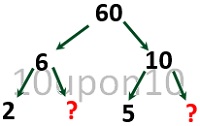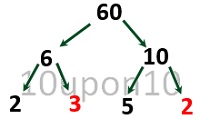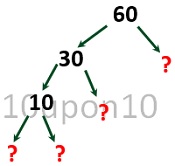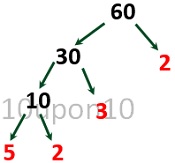NCERT Exercise 3.5 Part:2 Solution class six math
In this section question number 2 to 12 of NCERT Exercise 3.5 class six math have been solved. These questions are related to prime factorisation of numbers.
Question (2) Here are two different factor trees for 60. Write the missing numbers.
Question (2) (a)

Answer

Question (2) (b)

Answer

Question (3) Which factors are not included in the prime factorisation of a composite number?
Answer
1 and number itself are not included in the prime factorisation of a number.
Question (4) Write the greatest 4-digit number and express it in terms of its prime factors.
Answer
The greatest 4-digit number = 9999
Prime factorisation of 9999 = 3 × 3 × 11 × 101
Question (5) Write the smallest 5-digit number and express it in the form of its prime factors.
Answer
The smallest five digit number = 10000
The prime factors of 10000
= 2 × 2 × 2 × 2 × 5 × 5 × 5 × 5
Question (6) Find all the prime factors of 1729 and arrange them in ascending order. Now state the relation, if any; between two consecutive prime factors.
Answer
The prime factors of 1729 = 7 × 13 × 19
The relation between two prime factors of 1729 is the difference between them = 6
Question (7) The product of three consecutive numbers is always divisible by 6. Verify this statement with the help of some examples.
Answer
Example (a) Let three consecutive numbers = 4, 5, and 6
The product of 4, 5 and 6 = 4 × 5 × 6 = 120
Here 120 is divisible by 3
Example (b) Let three consecutive numbers = 3, 4 and 5
The product of 3, 4 and 5 = 3 × 4 × 5 = 60
Here 60 is divisible by 3
Example (c) Let three consecutive numbers = 7, 8, and 9
The product of 7, 8, and 9 = 7 × 8 × 9 = 504
Here 504 is divisible by 3
Question (8) The sum of two consecutive odd numbers is divisible by 4. Verify this statement with the help of some examples.
Answer
Example (a) Let two consecutive odd numbers = 5 and 7
The sum of 5 and 7 = 5 + 7 = 12
Here 12 is divisible by 4
Example (b) Let two consecutive odd numbers = 7 and 9
The sum of 7 and 9 = 7 + 9 = 16
Here 16 is divisible by 4
Example (c) Let two consecutive odd numbers = 9 and 11
The sum of 9 and 11 = 9 + 11 = 20
Here 20 is divisible by 4
Question (9) In which of the following expressions, prime factorisation has been done?
(a) 24 = 2 × 3 × 4
Answer: No. Prime factorisation has not been done.
Prime factorisation of 24 = 2 × 3 × 2× 2
(b) 56 = 7 × 2 × 2 × 2
Answer: Yes. Prime factorisation has been done.
(c) 70 = 2 × 5 × 7
Answer: Yes. Prime factorisation has been done.
(d) 54 = 2 × 3 × 9
Answer: No. Prime factorisation has not been done.
Prime factorisation of 54 = 2 × 3 × 3 × 3
Question (10) Determine if 25110 is divisible by 45
[Hint: 5 and 9 are co-prime numbers. Test the divisibility of the number by 5 and 9]
Solution
The prime factorisation of 45 = 5 × 9
Since, 25110 has zero as its last digit, so 25110 is divisible by 5
25110 ÷ 5 = 5022
Now, since the sum of digits of 5022 which is equal to 9 is divisible by 9, thus 5022 is divisible by 9
Since, 25110 is divisible by 5 × 9 which are prime factors of 45, thus 25110 is divisible by 45
Thus, 25110 is divisible by 45 Answer
Question (11) 18 is divisible by both 2 and 3. It is also divisible by 2 × 3 = 6. Similarly, a number is divisible by both 4 and 6. Can we say that the number must also be divisible by 4 × 6 = 24?
Answer: No
Example (a)
36 is divisible by 4 and 6 both. But 36 is not divisible by 4 × 6 = 24
Example (b)
12 is divisible by 4 and 6 both. But 12 is not divisible by 4 × 6 = 24
Question (12) I am the smallest number, having four different factors. Can you find me?
Solution
A number with smallest four different factors
= 2 × 3 × 5 × 7 = 210
Thus the required number is 210 Answer